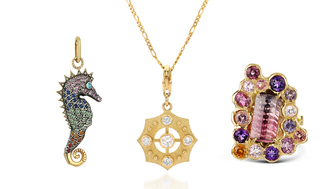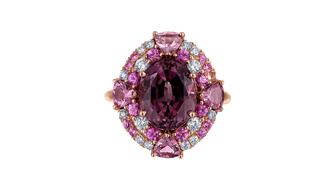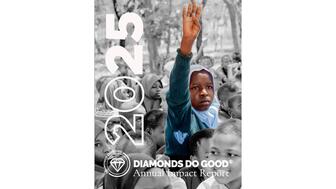Consumers Embracing Non-Traditional Ways to Mark Valentine’s Day
The NRF’s annual survey shows that consumer attitudes about how, or even whether, to celebrate Feb. 14 continue to evolve.

NRF conducted the survey between Jan. 3-11, polling 7,616 U.S. adult consumers.
Jewelry was the sixth most popular gift to give mentioned by survey-takers, behind the Valentine’s Day standards of candy (57 percent), greeting cards (40 percent), flowers (37 percent), an evening out (32 percent), and a gift of experience, meaning concert tickets, a spa day, skydiving, etc. (32 percent).
Twenty-one percent of consumers polled said they plan to give jewelry as a gift, with total spending potentially topping $5.5 billion.
Jewelry topped both gift cards (20 percent) and clothing (19 percent) as Valentine’s Day gifts this year.
The NRF’s survey also showed consumer attitudes about whether to celebrate Valentine’s Day, as well as how and with whom, continue to evolve in lockstep with attitudes about traditional romantic relationships.
The percentage of survey-takers who said they plan to celebrate Feb. 14 continues to hover around 50 percent (52 percent this year, down slightly from 53 percent last year), as it has for the past decade.
The last time the percentage of Valentine’s Day devotees topped 50 percent was 2013, when it stood at 60 percent.
However, a not-insignificant percentage of respondents said they plan to observe the day in a less traditional manner.
According to the NRF, 28 percent of the survey-takers who said they don’t plan to officially celebrate Valentine’s Day will still mark the day in some way, by seeking out non-Valentine’s Day gifts, treating themselves to something special, or planning a get-together or evening out with single friends and/or family members.
Meanwhile, those formally celebrating Feb. 14 plan to spend more money on people (or animals) who aren’t their significant others this year.
The average amount consumers plan to spend this Valentine’s Day is $192.80, up about $17 when compared with last year ($175.41).
While the average planned spending on gifts for significant others and family members held steady around $130, the amount people plan to spend on pets, friends, coworkers and their children’s teachers and/or classmates rose to $52.65 from $38.36 last year.
Some other points of note from the NRF’s Valentine’s Day survey:
-- Consumers ages 35 to 44 plan to spend the most of any age group, an average of $335.71 for gifts and other Valentine’s Day items;
-- The top shopping destination for Valentine’s Day gifts is online (35 percent), followed by department stores (34 percent), discount stores (31 percent) and specialty stores (18 percent);
-- More than half of consumers surveyed this year said they plan to take advantage of any sales or promotions; and
-- The percentage of consumers planning to give a gift of experience (32 percent) is up from 26 percent last year and 24 percent in 2021—when the pandemic hampered people’s ability to get out—and the highest since the NRF started asking about experiences-as-gifts in 2017.
The Latest

As the shopping mall model evolves and online retail grows, Smith shares his predictions for the future of physical stores.

The trade show is slated for Jan. 31-Feb. 2 at The Lighthouse in New York City's Chelsea neighborhood.

January’s birthstone comes in a rainbow of colors, from the traditional red to orange, purple, and green.

How Jewelers of America’s 20 Under 40 are leading to ensure a brighter future for the jewelry industry.

The annual report highlights how it supported communities in areas where natural diamonds are mined, crafted, and sold.


Footage of a fight breaking out in the NYC Diamond District was viewed millions of times on Instagram and Facebook.

The supplier has a curated list of must-have tools for jewelers doing in-house custom work this year.

Roseco’s 704-page catalog showcases new lab-grown diamonds, findings, tools & more—available in print or interactive digital editions.

The Signet Jewelers-owned store, which turned 100 last year, calls its new concept stores “The Edit.”

Linda Coutu is rejoining the precious metals provider as its director of sales.

The governing board welcomed two new members, Claire Scragg and Susan Eisen.

Sparkle with festive diamond jewelry as we celebrate the beginning of 2026.

The master jeweler, Olympian, former senator, and Korean War veteran founded the brand Nighthorse Jewelry.

In its annual report, Pinterest noted an increase in searches for brooches, heirloom jewelry, and ‘80s luxury.

Executive Chairman Richard Baker will take over the role as rumors swirl that a bankruptcy filing is imminent for the troubled retailer.

Mohr had just retired in June after more than two decades as Couture’s retailer liaison.

Shekhar Shah of Real Gems Inc. will serve as president of the Indian Diamond & Colorstone Association in 2026.

This year’s good luck charm features the mythical horse Pegasus, and is our first Piece of the Week of the new year.

Articles about crime, engagement rings, and a necklace worn in the World Series generated the most interest among readers.

As part of the leadership transition, Sherry Smith will take on the role of vice president of coaching strategy and development.

It marks the third time the country has headed the Kimberley Process. Ghana will serve as vice chair.

The new Bulova x Stetson designs highlight two animals often associated with the American West—the bison and the Texas Longhorn.

Its residency at Yamron Jewelers will run through May 2026.

From influential executives to innovative designers, we pay tribute to the people we said goodbye to this year.

The retailer is expanding into areas with large Indian and South Asian populations.

The Italian brand has opened its first flagship amid the peaks of the Dolomites in Madonna di Campiglio, Italy.

The new curation at the Natural History Museum of Los Angeles County showcases rare gem and mineral specimens in their uncut, natural state.





























